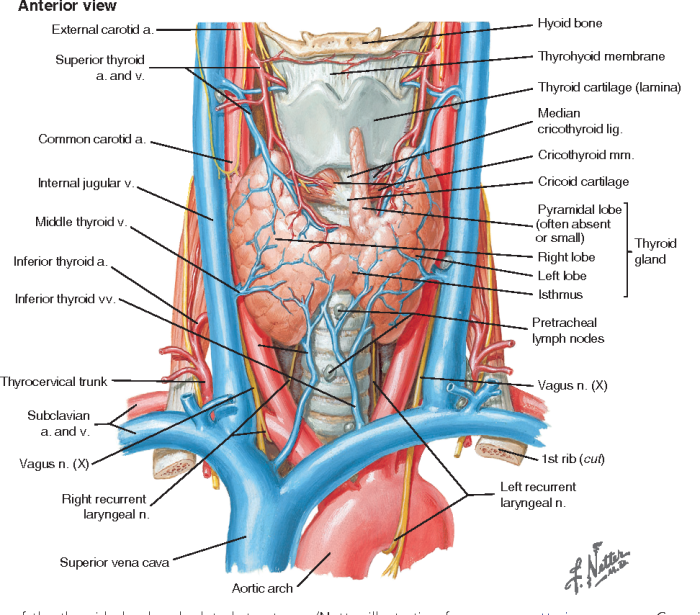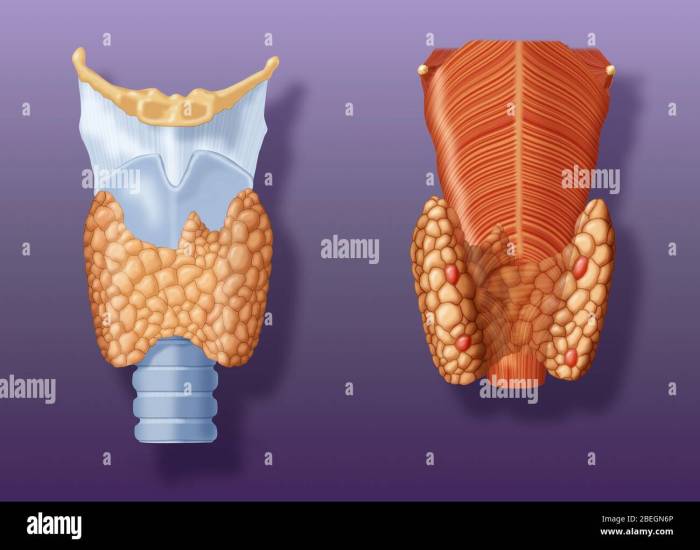Identify the highlighted region of the thyroid gland – In the realm of thyroid gland anatomy, the identification of the highlighted region stands as a crucial aspect, providing insights into its structure, function, and clinical significance. This exploration delves into the intricacies of the thyroid gland, unveiling its location, lobes, isthmus, and surrounding structures, laying the foundation for a comprehensive understanding of its role in maintaining overall health.
The thyroid gland, situated in the anterior neck region, comprises two lateral lobes connected by a central isthmus. Its proximity to the trachea and esophagus highlights its anatomical importance, while its rich blood supply and innervation ensure optimal functioning. Understanding the detailed anatomy of the thyroid gland serves as a cornerstone for accurate diagnosis and effective management of thyroid disorders.
Thyroid Gland Anatomy: Identify The Highlighted Region Of The Thyroid Gland

The thyroid gland is a small, butterfly-shaped gland located in the neck, just below the Adam’s apple. It consists of two lobes, connected by a narrow band of tissue called the isthmus. The lobes are located on either side of the trachea and esophagus.
The thyroid gland is supplied by blood from the superior and inferior thyroid arteries. It is innervated by the vagus nerve and the recurrent laryngeal nerve.
Thyroid Gland Function
The thyroid gland plays a crucial role in regulating metabolism. It secretes thyroid hormones, which are essential for the proper functioning of cells and tissues. Thyroid hormones regulate a wide range of bodily functions, including:
- Basal metabolic rate
- Growth and development
- Reproductive function
- Cardiovascular function
- Gastrointestinal function
Imaging Techniques for Thyroid Gland Evaluation
Ultrasound is the primary imaging technique used to evaluate the thyroid gland. It is a non-invasive and painless procedure that uses sound waves to create images of the gland. Ultrasound can be used to assess the size, shape, and structure of the thyroid gland, as well as to detect any abnormalities, such as nodules or cysts.
Computed tomography (CT) and magnetic resonance imaging (MRI) are also used to image the thyroid gland. CT scans use X-rays to create cross-sectional images of the gland, while MRI scans use magnetic fields and radio waves to create detailed images of the gland’s soft tissues.
Thyroid Gland Disorders, Identify the highlighted region of the thyroid gland
The thyroid gland can be affected by a variety of disorders, including:
- Hypothyroidism: A condition in which the thyroid gland does not produce enough thyroid hormones.
- Hyperthyroidism: A condition in which the thyroid gland produces too much thyroid hormones.
- Thyroid nodules: Growths that develop within the thyroid gland.
Surgical Management of Thyroid Gland Disorders
Surgery is the primary treatment for thyroid gland disorders. The type of surgery performed will depend on the specific disorder and the severity of the condition.
Thyroidectomy is a surgical procedure in which the thyroid gland is removed. It is the most common surgery performed for thyroid gland disorders.
Parathyroidectomy is a surgical procedure in which the parathyroid glands are removed. The parathyroid glands are small glands located near the thyroid gland that regulate calcium levels in the body.
Commonly Asked Questions
What is the significance of identifying the highlighted region of the thyroid gland?
Identifying the highlighted region of the thyroid gland is essential for understanding its anatomical structure, function, and relationship with surrounding structures. It aids in accurate diagnosis and effective management of thyroid disorders.
How is the thyroid gland located within the neck?
The thyroid gland is situated in the anterior neck region, below the larynx and in close proximity to the trachea and esophagus.
What are the lobes and isthmus of the thyroid gland?
The thyroid gland consists of two lateral lobes connected by a central isthmus, giving it a butterfly-like shape.

